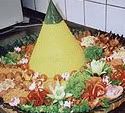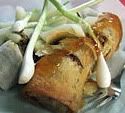
Rojak or Rujak
 Rojak is a fruit and vegetable salad dish commonly found in Malaysia, Singapore and Indonesia (where it is called Rujak). The term "Rojak" is Malay for mixture, is also used as a colloquial expression for an eclectic mix, and in particular is often used to describe the multi-ethnic character of Malaysian and Singaporean society.
Rojak is a fruit and vegetable salad dish commonly found in Malaysia, Singapore and Indonesia (where it is called Rujak). The term "Rojak" is Malay for mixture, is also used as a colloquial expression for an eclectic mix, and in particular is often used to describe the multi-ethnic character of Malaysian and Singaporean society.In Indonesia, especially among Javanese, rujak is an essential part of the traditional prenatal ceremony called "Tujuh Bulanan" (literally: seventh month). Special fruit rujak is made for this occasion, and later served to the mother-to-be and her guests, primarily her female friends). It is widely known that the sweet, spicy and sour tastes of rojak are adored by pregnant women. The recipe of rujak for this ceremony is similar to typical Indonesian fruit rujak, with the exceptions that the fruits are roughly shredded instead of thinly sliced, and that pomelo/pink grapefruit is an essential ingredient. It is believed that if the rujak overall tastes sweet, the unborn would be a girl, and if it is spicy, the unborn baby is a boy.
Indonesian Fruit Rujak
The typical Indonesian fruit rujak consists of slices of assorted tropical fruits such as jambu air (water apple), pineapple, raw mangoes, bengkoang (jicama), cucumber, kedondong, and raw red ubi jalar (sweet potato). Sometimes Malang variants of green apple, belimbing, and jeruk Bali (pomelo) are added. The sweet and spicy-hot bumbu rujak dressing is made of water, gula jawa (palm sugar), asem jawa (tamarind), ground sauteed peanuts, terasi (shrimp paste), salt, bird's eye chili, and red chili. All of the fruits are sliced to bite-size, and put in the dish. The bumbu rujak or thick sweet spicy rujak dressing is poured on the fruit slices. An addition of sambal garam powder (simple mixture of salt and ground red chilli) is put on side as the alternative for those who love a salty taste for their rujak.
Rujak Tumbuk (Rujak Bebek)
- This is another variant of Indonesian fruit rujak. The ingredients are almost the same as typical Indonesian fruit rujak, with the exception that all the ingredients are mashed together (tumbuk or bèbèk in Indonesian) in a wooden mortar. The dressing is not poured on the fruit, but already mixed together with all the ingredients. Rujak tumbuk is served in individual smaller portions on banana leaf plates called "pincuk".
- This literally means "shredded rujak", and is another variant of Indonesian fruit rujak. As with rujak tumbuk, the ingredients are similar to Indonesian fruit rujak, with the exceptions that the fruits are not cut into bite-sized pieces, but shredded into a roughly grated consistency.
- A delicacy from Aceh province, this rujak consists of very young and tender coconut meat, young (green) papaya, bird's eye chili, sugar, Palm sugar, ice, salt, and a dash of lime. Best eaten cold.
- "Pengantin" means bride/groom in Indonesian. This rujak is reminiscent of Indonesia's colonial cuisine. It contains slices of boiled eggs, potatoes, fried tofu, pineapple, carrot, bean sprout, pickles, chili, lettuce, cabbage, cucumber, emping crackers, roasted peanuts, peanut sauce and has a little vinegar to it. Some variants mixed the peanut sauce with mayonnaise. It is somewhat like Central Javanese Gado gado.
- A Balinese snack, a variation of the Indonesian fruit rujak, but instead of the the normal rujak dressing, the fruits are soaked in a spiced fish broth. The broth consists of terasi (shrimp paste), salt, bird's eye chili, and red chili and fish broth.
- Literally meaning mouth in Javanese, "cingur" (pronounced: ching-oor) is a variant of rujak from Surabaya. This specialty rujak from East Java has a "meaty" taste. It contains slices of cooked buffalo or beef lips, bangkuang, young raw mango, pineapple, cucumber, kangkung, lontong (rice cake), tofu and tempe, all served in a black sauce made from petis (black fermented shrimp paste, related to terasi), and ground peanuts. It is topped with a sprinkle of fried shallots and kerupuk (Indonesian shrimp crackers).
- This is another variant of rujak from Surabaya. It contains slices of bangkuang, unripe raw mango, cucumber, kangkung, kedondong, tofu, and soy bean sprouts all served in a black sauce made from petis (sticky black fermented shrimp paste, related to terasi), fried shallots, salt, Palm sugar, unripe banana, and ground peanuts. Traditionally it is served on a banana leaf, but today it is more commonly served on plates.
- Juhi means salted cuttlefish in Indonesian; this rujak contains fried takwa tofu, fried boiled potatoes, fried cuttlefish, cucumber, noodles, lettuce, cabbages, peanut sauce, vinegar, chili, and fried garlic.
- Named after China's most populated city, Shanghai, this dish was created by Indonesia's Chinese community. This variant of rujak can be found in Indonesian Chinatowns in cities such as Glodok and Jakarta. Rujak Shanghai contains seafood, like Rujak Juhi. Boiled and sliced gurita (octopus) and teripang (sea cucumber) is served with kangkung (a leafy green water plant commonly used as vegetable), and served with thick red sweet and sour sauce, mixed with pineapple juice, and sauteed ground peanuts. Usually chili sauce and pickled bengkoang are served as condiments.
- A delicacy from Banyuwangi, East Java, a unique blend between beef soto and rujak cingur. A local specialty in which the rujak is poured with soto. The rujak cingur itself doesn't contain petis as one of its ingredient. Created at 1975 by Usni Solihin. (source)



















0 comments:
Post a Comment